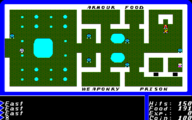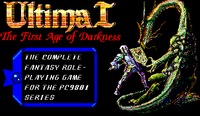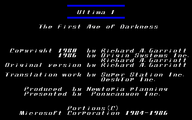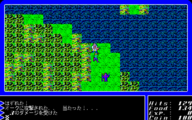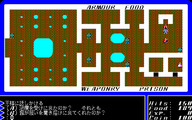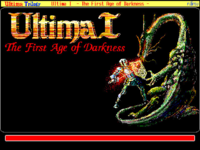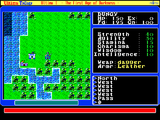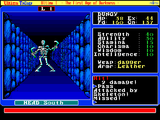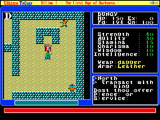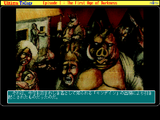Computer ports of Ultima I
Ultima I comes in two versions. The original game from 1981 was released only on the Apple II and later converted for the Atari 800 (same code used). The later remake created in 1986 had ports of the game for various systems.
The Original Game[edit]
The Apple II Original[edit]
This was the very first incarnation of the game, the one that held the name "Ultima" for the first time.
The game sported a (for the time) impressive representation of the terrain with the help of tiles. However, nothing was yet animated (animation of water tiles came in Ultima II, animated characters made their debut in Ultima III). A fun fact is, that the title picture was drawn by no other than Denis Loubet. The graphics tablet he had to use was so poorly made, it constantly broke down. He himself was amazed he still got the job done properly.
Much of the game was programmed in Applesoft BASIC, making it hard to port it to other systems with different BASIC dialects. The game is also plagued by glitches and other programming errors (something that was common at the time). The keyboard assignment for the movement keys only forms (roughly) a diamond on the original Apple II and Apple II+ systems, which makes the game awkward to use on the later Apple IIe system. Additionally, the game is incompatible with the enhanced Apple IIe, the Apple IIc, Apple IIc+, and Apple IIGS, because the outer-space combat section uses so-called illegal opcodes of the MOS Technology 6502 CPU used in the first Apples, which do not exist on the Western Design Center 65C02 and 65816 CPUs used in the later systems. The symptom of this is that the space combats are not winnable on the mentioned newer Apple models, which makes completion of the game impossible.
There also is another problem. Due to a bug with the dungeons, their layout never stays the same, as it should be, and instead is changed every time when entering the level again. This does make mapping virtually impossible.
The game was released on a single double-sided 5.25" floppy disk.
The Atari 8-bit-Port[edit]
In 1983, Sierra On-Line re-released the game on the Atari 800. The game was converted by Sigma Micro Systems. The game is virtually unchanged from the Apple II release. This was the only Ultima that utilized the Atari's color graphic modes for the main window. Though numerous colors are available the developers decided to match the Apple II look as much as possible. This version of Ultima should look nearly the same across the Atari 8-bit line, including the European (PAL) Ataris.
All of the glitches of the original version were kept in the Atari 800-port. One small new detail was added: The four continents got names for the first time, namely "The Continent of Ho", "... of Eyo", "... of He", and "... of Hum". The names were taken from the song of the jester and they are of course different from the names later adopted in the re-release.
It was released on a single 5.25" floppy disk.
The 1986 Remake[edit]
The Apple II-Port[edit]
Compared to the original version of the game, the remake got improved looks and runs very noticeably faster. It was also written entirely in assembly language, making porting issues trivial. A new title screen and some text screens were added and many aspects of the game were revised. While towns and castles did not each have their own unique maps, at least there were now four different city maps and two different castle maps. Wandering monsters on the overworld were now included, which removed the need to constantly enter dungeons to gain experience.
The graphics, while still looking a little like the original, are somewhat more detailed, and tiles are now animated. All of the original's infamous glitches were removed as well.
The game was released on a single 5.25" disk.
The C64-Port[edit]
The port for the C64 is in many ways a lot like the one on the Apple II.
The similarities between the two ports are no coincidence, since they do share much of the same code due to the very similar system construction of the two systems. One difference is the graphics. The graphics of the C64-port make full use of the system's video capabilities. Everything is much more colorful and the colors are not as distorted and restricted as they sometimes are on the Apple II. The improvement in color assignment is especially noticeable in the towns (just look at the walls).
The game was sold on a single 5.25" floppy disk.
C64 – The city of Britain
The IBM PC-Port[edit]
The port for the IBM PC was finished one year after the other two. Since it is a 16-bit system, things are quite different here.
Right from the start, the graphics of this port are clearly superior to the ones on the C64 and Apple II. The game is using a 16-colors EGA mode, which is the same number of colors as the C64, but unlike the C64, the PC EGA hardware has fewer limitations on placement of colors than the C64 with its color cells system. The port also got a new title screen, which looks nicer than the one on the other two ports, but in turn is only minimally animated.
The port however does have a problem: there is no frame limiter built into the game, which makes it virtually impossible to play it on a modern system, unless being artificially slowed down. Since the PC has a CPU that is very different from those used in the C64 and the Apple II, the assembly code for the game had to be rewritten, introducing some new bugs. For example, armor does not protect the player at all while in the dungeons, which makes the fights in there much harder than on the Apple and C64 versions of the re-release.
The port was sold on a single 5.25" floppy disk and is still commonly available on various compilations.
IBM PC – Fighting a balron
The Apple IIGS-Port[edit]
(Text from http://users.foxvalley.net/~joko/ultima.html) In 1994, IIGS programming master Rebecca Heineman assembled the same team of programmers, musicians and artists who ported "Out of this World" to the IIGS, with the goal of creating an updated GS/OS-specific version of Ultima I for the IIGS. With super hi-res graphics and a synthLAB-based musical soundtrack, Ultima I for the IIGS was brought to market by Vitesse, and it received critical acclaim from Apple IIGS game players.
Ultima I for the IIGS was available for sale for only a short time, as Vitesse is no longer in business. But, in order to assure that even new IIGS owners could partake in the same joys as previous generations of Apple II users, Rebecca Heineman and Joe Kohn teamed up again to make the IIGS version of Ultima I available from Joe Kohn's small software distribution business, Shareware Solutions II. Unfortunately, Mr. Kohn passed away in January 2010, and as of January 2011 the page for purchasing items online from Shareware Solutions II was no longer accessible.
Japanese-Only-Ports[edit]
The MSX2-Port[edit]
This port, like all 1989 ports, was created by PonyCanyon and only released in Japan. Unlike other Japanese ports of Ultima games, there is no English version available.
This port offers a whole new tileset which is much more colored than the original graphics and in higher (512x212) resolution, as well as totally original music. All enemies in the dungeon are also represented by bitmaps rather than line art. Outside of these cosmetic differences, the game is an exact copy of the 1986 remake. Of note is that Pony Canyon made all of their ports from one base and this one has the worst graphics of these ports, since the resolution is not optimal.
The PC-8801-Port[edit]
This port of Ultima I for the PC-8801 was released in Japan in 1989 by PonyCanyon, and was re-released in 1998 as a part of the Japanese version of the Ultima Collection. The original translation was done by Miyo-C/Desktop Inc., and was released by Pony Canyon Inc.
Gameplay is similar to the PC version of Ultima I, but features improved tile graphics and dungeon graphics identical to the MSX2 version featured above. Of note is that PonyCanyon made all of their ports from one base, and this one has not the best graphics of these ports, since the resolution is not optimal.
PC-8801 – The City Britian [sic]
The PC-9801-Port[edit]
This port of Ultima I for the PC-9801 was released in Japan in 1988 and distributed by PonyCanyon. It is based on the 1986 remake and comes in the usual videotape like box featuring the original cover art work. Instead of the separate cardboard maps, the four images are now printed side by side on a single cloth map. In 1998 it was re-released in the Japanese Ultima Collection who was published by LOCUS.
Gameplay is similar to the PC version of Ultima I, but features a high-resolution and multi-piece soundtrack. Of note is that Pony Canyon made all of their ports from one base, and this one has the best resolution of the graphics, thus indicating this system was the one for which the port was originally developed.
The FM Towns-Port[edit]
This port of Ultima I was made as part of the FM Towns Ultima Trilogy I II III compilation, and released by Fujitsu in 1990. As such it offers redrawn graphics with a new tile set that was also used for the FM Towns version of Ultima II and Ultima III. Additionally, cities and castles are on the same scale as the wilderness, meaning that unlike all other versions, they are multi-screen instead of single-screen.
In addition it also offers newly composed music. Like the graphics, this music was also used for the other two titles of the compilation.
Like most FM Town-ports, it is also offers a new hi-resolution introduction the player can watch outside the game, but unlike the game, the introduction has no English translation and can only be watched in Japanese.
The game was only released as part of a compilation and only in Japan. Outside of Japan, it is nearly completely unknown.
FM Towns – Lord British
FM Towns – Mondain's hordes
External Links[edit]
- YouTube - Ultima I - FM Towns Introduction
- YouTube - Ultima I Gameplay Video (Tandy)
- YouTube - Ultima I Introduction (Commodore 64)
- YouTube - Ultima I Gameplay Video (PC - 1986)
| Computer Ports | |
|---|---|
| Games | Ultima I ☥ Ultima II ☥ Ultima III ☥ Ultima IV ☥ Ultima V ☥ Ultima VI ☥ Savage Empire |
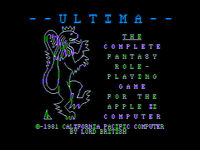
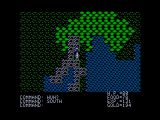
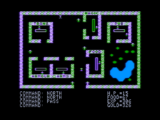
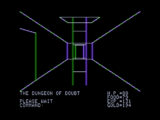
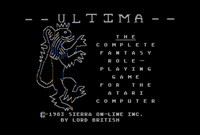
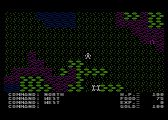
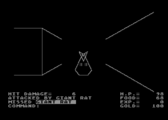
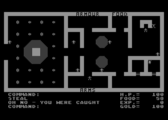
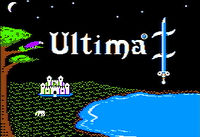
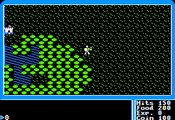
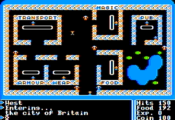
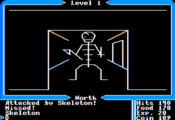
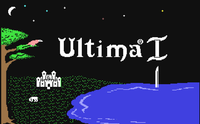
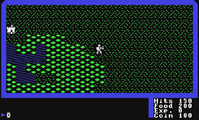
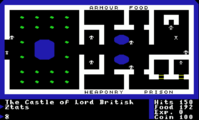
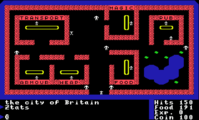
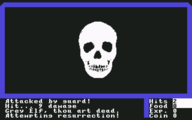
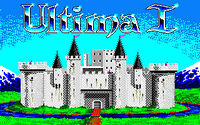
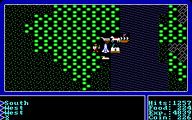
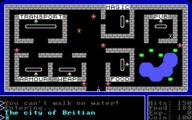
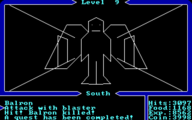
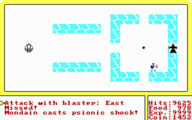
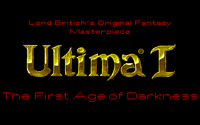
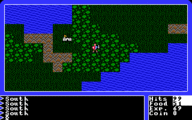
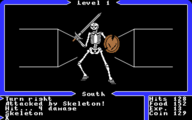
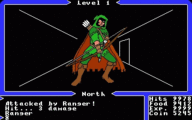
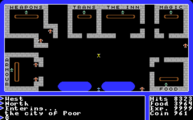
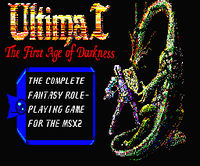
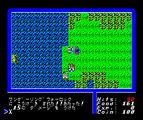
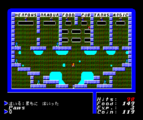
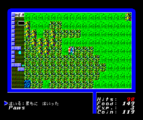
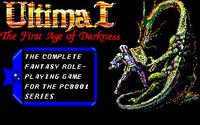
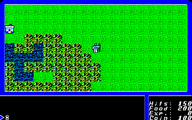
![PC-8801 – The City Britian [sic]](/images/thumb/0/02/BritainPC-88U1.png/192px-BritainPC-88U1.png)
